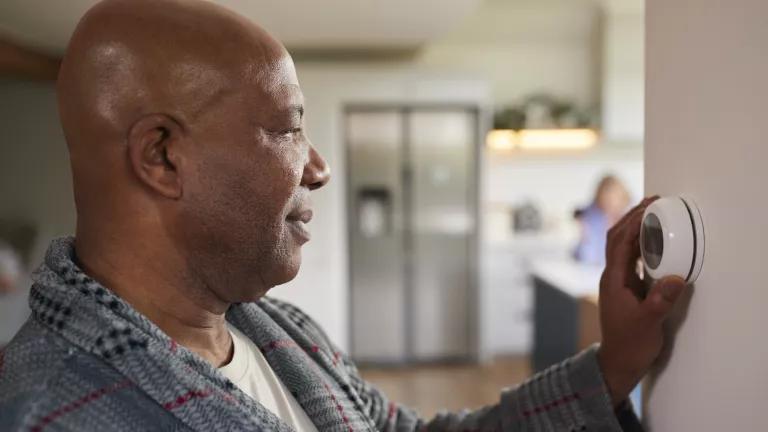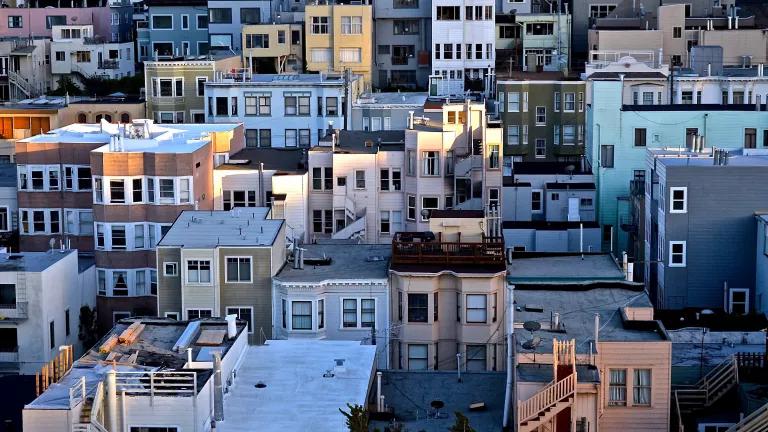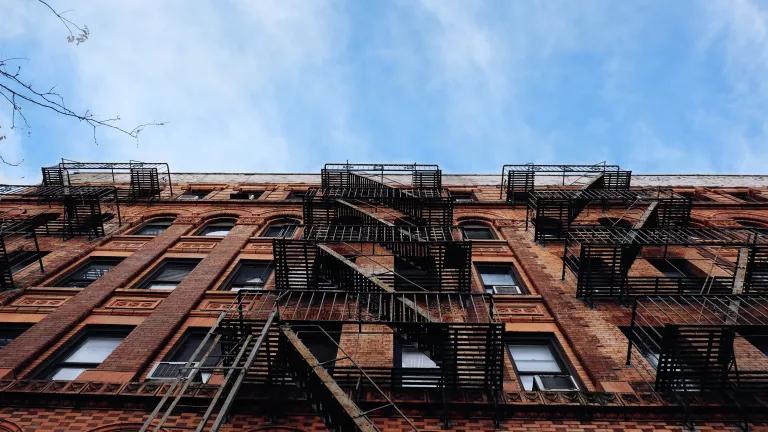Supercharge EmPOWER to Ensure No Marylander Gets Left Behind
Creating a low-income energy savings target can ensure that Maryland’s energy efficiency program works toward equity—not against it.

A worker installs mineral wool insulation in the attic of a home.
It’s time for Maryland to take its energy efficiency policy to the next level.
That’s the message of a new report from Maryland PIRG that takes a deep dive into EmPOWER, the state’s flagship energy efficiency program. As the report chronicles, despite laudable successes, EmPOWER is struggling to meet the demands of the moment. The program is regressive and racially unjust, having done a particularly poor job serving limited-income Marylanders—the very population most in need of utility bill–reducing energy efficiency improvements.
Maryland has an opportunity to fix this problem by enacting Senate Bill 144 (and companion House Bill 169). This legislation would drive better outcomes by creating a dedicated low-income energy savings target—a solution endorsed in the Maryland PIRG report by an array of public interest groups and by then candidate (now governor) Wes Moore.
The problem: EmPOWER Maryland is fueling energy inequity
To understand the need for a low-income energy savings target, it’s helpful to review the history of EmPOWER. The program was created in 2008 with the goal of achieving a 15 percent reduction in per capita electricity consumption by 2015. Initially, Maryland’s five largest utility companies were responsible for delivering the energy efficiency programs to all households, including limited-income households. Concerns about the utilities’ performance in delivering the limited-income programs led state regulators to transfer control of those programs to the state Department of Housing and Community Development (DHCD) in 2012.
Since its inception, EmPOWER has achieved remarkable success. The 2015 savings goal was met statewide, and the savings target was updated in 2017 to a 2 percent annual reduction in gross energy sales. (Last year’s Climate Solutions Now Act raises that goal to 2.5 percent annual savings by 2027.) The program has already saved Marylanders more than $4 billion on their energy bills and reduced statewide greenhouse gas emissions by at least 9.6 million metric tons.
Unfortunately, as the Maryland PIRG report documents, the DHCD-operated limited-income programs have languished. Unlike with the utility-operated programs, there is no mandatory savings target for the limited-income programs. In 2021, DHCD achieved only 70 percent of its nonbinding target for single-family households and a dismal 9 percent of its goal for multifamily households. To date, the program has served less than 50,000 of the state’s nearly 590,000 limited-income households—at which rate it would take between 130 and 148 years to serve all qualifying households.
The slow pace is particularly troubling because of the crucial role that energy efficiency can play in addressing energy poverty. Many low-income households in Maryland live in drafty buildings and lack adequate insulation and energy-efficient appliances. As a result, on average, low-income Marylanders pay more than 13 percent of their household budget on energy bills, which is more than twice what's considered affordable. Research shows this energy cost burden is racially unjust, hitting Black and brown households hardest.
By reducing and stabilizing home energy use, energy efficiency improvements enable households struggling with high monthly energy bills to manage their budget and maintain access to essential energy services. Energy efficiency also provides a wealth of other benefits, including healthier air quality and safer, more comfortable home temperatures.
Under the EmPOWER program, however, households that would benefit most from energy efficiency services are often being served last. Because all Maryland households pay the same amount for the program via utility bill surcharges, limited-income Marylanders are also putting more into the program than they are getting out. From 2021 to 2023, limited-income households contributed nearly $49 million toward the program but only received $28 million in benefits. Rather than serving as a solution to energy poverty, the EmPOWER program is draining money from limited-income communities and driving a growing wedge between poorer and wealthier households.
The solution: a dedicated low-income energy savings target
Maryland has an opportunity to transform EmPOWER from a driver of inequity to a powerful engine for energy equity. Senate Bill 144 and House Bill 169 would meaningfully amend the EmPOWER program by creating a dedicated low-income savings target, bringing DHCD-operated limited-income programs closer to parity with the utility-operated programs. The bill creates an achievable target of a 0.53 percent annual reduction in energy sales to limited-income households for 2024, ramping up to a 1 percent annual reduction target in 2026. It would also require DHCD to serve all qualifying households by 2031.
Encouragingly, Governor Moore has already announced his support for a low-income savings target in Maryland. After then-governor Larry Hogan vetoed the bill in 2022, then candidate Moore tweeted this:

Investments in equity that Maryland can afford
So this isn’t the first time that a low-income savings target has been proposed in Maryland. A bill passed both houses of the General Assembly last year—with a unanimous vote from the state senate—before an unexpected last-minute veto, ostensibly due to the cost of the program.
That’s misguided for the following three reasons.
First, the complementary energy savings target for low-income homes is not about spending more but spending more equitably and more impactfully. Notably, Maryland’s utilities have significantly underspent on energy efficiency programs in recent years. Rather than leaving that money on the table, Maryland should direct those funds to the underserved households that need them most.
Second, as with all EmPOWER investments, costs must be considered alongside the myriad benefits of energy efficiency on the other side of the ledger—to the economy, the environment, and public health. Better-targeted energy efficiency programs reduce racial inequities due to unevenly distributed energy cost burdens. They are massive job creators and essential to achieving climate goals. As noted above, they also promote public health by enabling households to stay connected to essential energy services and improving indoor air quality and comfort.
Utilities themselves benefit, since low-income programs allow households to afford their monthly bill, increasing the timeliness and volume of payments to utilities and reducing costs associated with arrearages and shutoffs.
Third, there is significant federal funding available for low-income energy efficiency through the Inflation Reduction Act that can further defray the costs of ramping up Maryland’s low-income programs. By integrating those funding streams with a robust low-income energy efficiency program, Maryland can maximize the benefits of those federal dollars for its residents.
EmPOWER Maryland promises energy efficiency for homes statewide. But too many Marylanders have been left behind without targets driving services directly to low-income households. The best time to deliver on EmPOWER’s promise was when the program was launched. The next best time is now. Let’s get this done.



